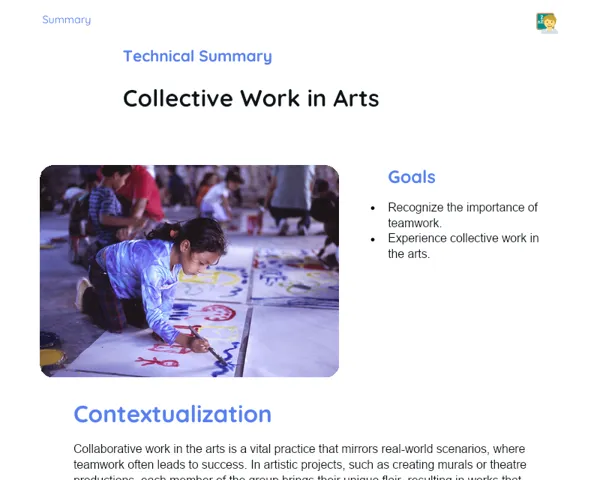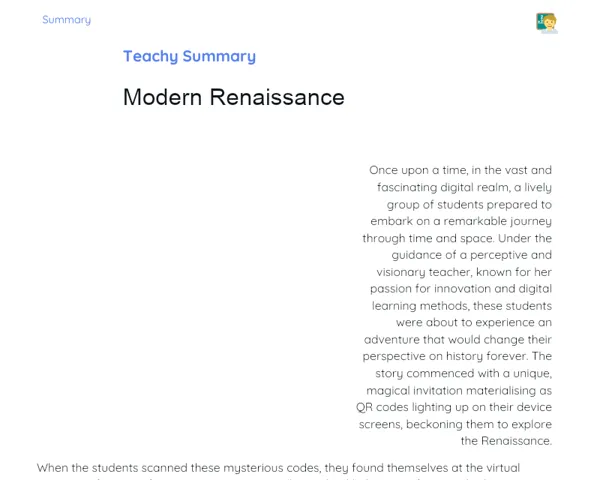Objectives
1. 🎨 Grasp the concept of art as a fundamental expression of human emotions and the thoughtful creation of artistic works.
2. 🔍 Build skills to analyze and interpret art pieces, delving into diverse contexts and styles.
3. 🤝 Enhance collaboration and effective communication during group artistic activities.
Contextualization
Did you know that rock art found in ancient caves is one of the earliest forms of artistic expression by humans? These paintings, which date back thousands of years, not only capture the lives and thoughts of people from that era but also demonstrate how art has always been a powerful means of connecting and conveying ideas, emotions, and cultures. This captivating early chapter in art history reminds us that regardless of the time period, art as a form of human expression has consistently evolved while staying true to its core essence.
Important Topics
Subjective Expression
Subjective expression in art highlights the artist's ability to convey their feelings, opinions, and personal interpretations through their creations. Every painting, sculpture, or installation serves as a visual narrative of the artist's unique experiences and perspectives. This aspect of art is crucial in understanding how creativity can serve to explore and communicate both personal and societal issues.
-
The significance of subjectivity in art: Each artwork mirrors the artist and their circumstances, making it distinctive and valuable.
-
Personal interpretation: Viewers are encouraged to perceive the work based on their own backgrounds, enriching the conversation between the audience and the artwork.
-
Use of materials and techniques: Artists employ their technical prowess to express feelings and concepts, thoughtfully selecting materials that enhance their message.
Conscious Production of Works
The conscious production of artistic works entails a deliberate creative process, where the artist makes informed choices regarding theme, style, techniques, and materials. This level of awareness enables the artist to express their intent clearly, ensuring the art is experienced and understood as they envisioned.
-
Artistic planning: Prior to starting, artists typically engage in sketching and preparatory studies to refine their vision.
-
Material and technique selection: Different materials and methods evoke distinct visual and emotional responses, chosen deliberately by the artist to convey their intended message.
-
Ongoing review and adaptation: During creation, artists continually assess and modify their work to align it with their original vision.
Critical Analysis and Interpretation
Engaging in the analysis and interpretation of art demands more than mere observation; it is a journey of exploration that takes into account historical, cultural, and personal contexts. Through analysis, scholars and art lovers can unveil the layers of meaning embedded in a piece, thereby enriching the aesthetic experience.
-
Historical and cultural context: Recognizing the circumstances under which the artwork was produced is vital for understanding its meaning.
-
Analysis methodologies: Various methods, such as formal, iconographic, and contextual analysis, uncover the artist's intentions.
-
Dialogue with previous works: Artists frequently respond to or converse with the creations of prior artists, adding new dimensions to interpretation.
Key Terms
-
Subjective Expression: Pertains to the artist's ability to communicate their feelings and personal views through their artwork.
-
Conscious Production: The intentional artistic creation process that involves thoughtful decisions about theme, style, materials, and techniques to convey a specific message.
-
Critical Analysis: An in-depth exploration of art that considers visual aspects as well as historical, cultural context, and the artist's intentions.
For Reflection
-
How does an artist's subjectivity influence their understanding of a work of art? Share examples that illustrate this.
-
In what ways can the historical and cultural context shift the interpretation of a timeless piece of art?
-
Why is it crucial for an artist to have a clear understanding of their vision before starting the creative process? Discuss its benefits and potential challenges.
Important Conclusions
-
We examined art as a dynamic expression of human subjectivity, where artists deftly use a range of materials and techniques to convey emotions, ideas, and social critiques.
-
We highlighted how the conscious creation of artworks involves thoughtful planning and choices that influence public interpretation, underlining the significance of historical and cultural contexts.
-
We explored how art can be critically interpreted through various methodologies that help reveal the intentions and meanings embedded in artworks.
To Exercise Knowledge
Create an 'Artist's Diary' to document a week of your life, expressing your emotions and experiences through drawings, collages, or other artistic mediums. Consider using various materials and techniques to communicate a range of feelings and stories.
Challenge
Young Curator Challenge: Designate a wall in your home to showcase a mini art exhibition featuring your own creations or those of friends and family. Pick a theme that resonates with you and write brief descriptions for each piece, articulating its connection to the theme.
Study Tips
-
Tour museums, whether virtually or in-person, to explore diverse artistic styles and eras. Try applying the critical analysis techniques you’ve learned to the artworks you encounter.
-
Engage in art workshops or online classes to experiment with new techniques and broaden your artistic skills, facilitating a deeper understanding of artists’ choices in their works.
-
Maintain an artistic journal to jot down sketches, ideas, and inspirations throughout your day. This practice will help you develop your individual style and refine your artistic expression.



